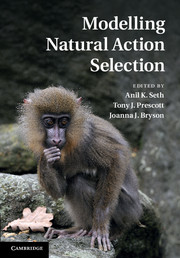Book contents
- Frontmatter
- Contents
- Foreword
- Preface
- Contributors
- 1 General introduction
- Part I Rational and optimal decision making
- Part II Computational neuroscience models
- 9 Introduction to Part II: computational neuroscience models
- 10 Action selection and refinement in subcortical loops through basal ganglia and cerebellum
- 11 Cortical mechanisms of action selection: the affordance competition hypothesis
- 12 Toward an executive without a homunculus: computational models of the prefrontal cortex/basal ganglia system
- 13 Hierarchically organised behaviour and its neural foundations: a reinforcement-learning perspective
- 14 The medial reticular formation: a brainstem substrate for simple action selection?
- 15 Understanding decision-making deficits in neurological conditions: insights from models of natural action selection
- 16 Biologically constrained action selection improves cognitive control in a model of the Stroop task
- 17 Mechanisms of choice in the primate brain: a quick look at positive feedback
- Part III Action selection in social contexts
- Index
- Plate section
- References
11 - Cortical mechanisms of action selection: the affordance competition hypothesis
from Part II - Computational neuroscience models
Published online by Cambridge University Press: 05 November 2011
- Frontmatter
- Contents
- Foreword
- Preface
- Contributors
- 1 General introduction
- Part I Rational and optimal decision making
- Part II Computational neuroscience models
- 9 Introduction to Part II: computational neuroscience models
- 10 Action selection and refinement in subcortical loops through basal ganglia and cerebellum
- 11 Cortical mechanisms of action selection: the affordance competition hypothesis
- 12 Toward an executive without a homunculus: computational models of the prefrontal cortex/basal ganglia system
- 13 Hierarchically organised behaviour and its neural foundations: a reinforcement-learning perspective
- 14 The medial reticular formation: a brainstem substrate for simple action selection?
- 15 Understanding decision-making deficits in neurological conditions: insights from models of natural action selection
- 16 Biologically constrained action selection improves cognitive control in a model of the Stroop task
- 17 Mechanisms of choice in the primate brain: a quick look at positive feedback
- Part III Action selection in social contexts
- Index
- Plate section
- References
Summary
Summary
At every moment, the natural world presents animals with two fundamental pragmatic problems: selection between actions that are currently possible, and specification of the parameters or metrics of those actions. It is commonly suggested that the brain addresses these by first constructing representations of the world on which to build knowledge and make a decision, and then by computing and executing an action plan. However, neurophysiological data argues against this serial viewpoint. In contrast, it is proposed here that the brain processes sensory information to specify, in parallel, several potential actions that are currently available. These potential actions compete against each other for further processing, while information is collected to bias that competition until a single response is selected. The hypothesis suggests that the dorsal visual system specifies actions which compete against each other within the fronto-parietal cortex, while a variety of biasing influences are provided by prefrontal regions and the basal ganglia. A computational model is described which illustrates how that competition may take place in the cerebral cortex. Simulations of the model capture qualitative features of neurophysiological data and reproduce various behavioural phenomena.
Introduction
At every moment, the natural environment presents animals with many opportunities and demands for action. The presence of food offers an opportunity to satiate hunger, while the appearance of a predator demands caution or evasion. An animal cannot perform all of these behaviours at the same time because they often share the same effectors (you only have two hands; you can only transport yourself in one direction at a time, etc.). Thus, one fundamental issue faced by every behaving creature is the question of action selection. That question must be resolved, in part, by using external sensory information about objects in the world, and in part, by using internal information about current behavioural needs.
Information
- Type
- Chapter
- Information
- Modelling Natural Action Selection , pp. 208 - 238Publisher: Cambridge University PressPrint publication year: 2011
References
Accessibility standard: Unknown
Why this information is here
This section outlines the accessibility features of this content - including support for screen readers, full keyboard navigation and high-contrast display options. This may not be relevant for you.Accessibility Information
- 4
- Cited by
